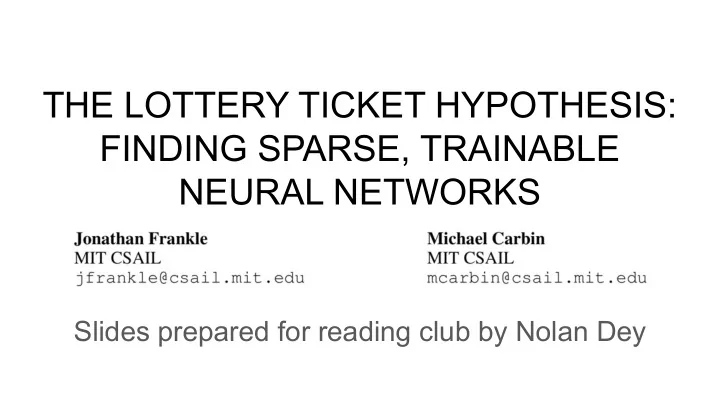

THE LOTTERY TICKET HYPOTHESIS: FINDING SPARSE, TRAINABLE NEURAL NETWORKS Slides prepared for reading club by Nolan Dey
Motivation - Pruning techniques can reduce parameter counts by 90% without harming accuracy Train Prune 90% accuracy 90% accuracy
Motivation Pruning techniques can reduce parameter counts by 90% without harming accuracy Randomly initialize Prune weights and train 90% accuracy 90% accuracy
Motivation Randomly initialize Prune weights and train 90% accuracy 90% accuracy Randomly initialize 😠 weights and train 60% accuracy
The Lottery Ticket Hypothesis A randomly-initialized, dense neural network contains a subnetwork that is initialized such that—when trained in isolation—it can match the test accuracy of the original network after training for at most the same number of iterations.
The Lottery Ticket Hypothesis Randomly initialize Prune weights and train 90% accuracy 90% accuracy Use same weight 😋 initialization and train 90% accuracy
Lottery Analogy - If you want to win the lottery, just buy a lot of tickets and some will likely win - Buying a lot of tickets = having an overparameterized neural network for your task - Winning the lottery = training a network with high accuracy - Winning ticket = pruned subnetwork which achieves high accuracy
Identifying Winning Tickets One-shot pruning 1. Randomly initialize a neural network 2. Train the network 3. Prune p%** of weights with lowest magnitude from each layer (set them to 0) 4. Reset pruned network parameters to the original random initialization Iterative pruning - Iteratively repeat the one-shot pruning process - Yields smaller networks than one-shot pruning **Connections to outputs are pruned at 50% of the pruning rate
Results - Tested with fully connected, convolutional, and ResNet on MNIST and CIFAR-10 - Pruned subnetworks are 10-20% smaller than the original and meet or exceed original test accuracy in at most the same number of iterations - Works with different optimizers (SGD, momentum, Adam), dropout, weight decay, batchnorm, residual connections - Sensitive to learning rate: requires a number of “warmup” iterations to find winning tickets at higher learning rates
Discussion - Are winning initializations already close to fully-trained values? - No! They actually change more during training than the other parameters - Perhaps winning initializations might land in a region of the loss landscape that is particularly amenable to optimization - They conjecture that SGD seeks out a trains a winning ticket in an overparameterized network - Pruned subnetworks generalize better (smaller difference between train and test accuracies)
Limitations - Iterative pruning is computationally intensive -> involves training a network 15 times per trial - Hard to study larger datasets like ImageNet - Future work: find more efficient methods of finding winning tickets - Their winning tickets are not optimized for modern libraries or hardware - Future work: maybe non-magnitude based pruning methods could find smaller winning tickets earlier
Let’s Discuss
Recommend
More recommend